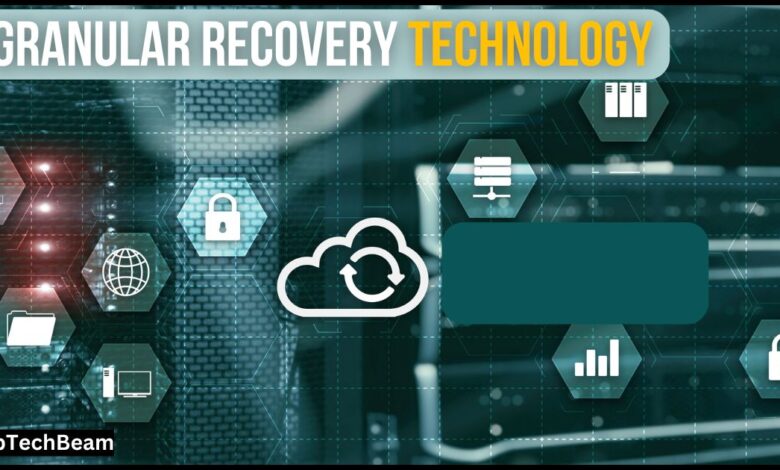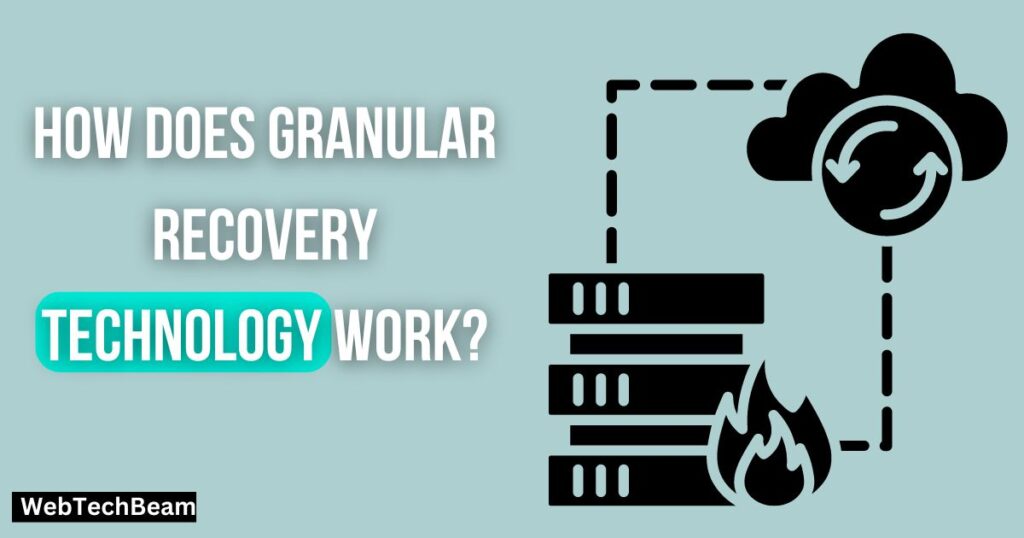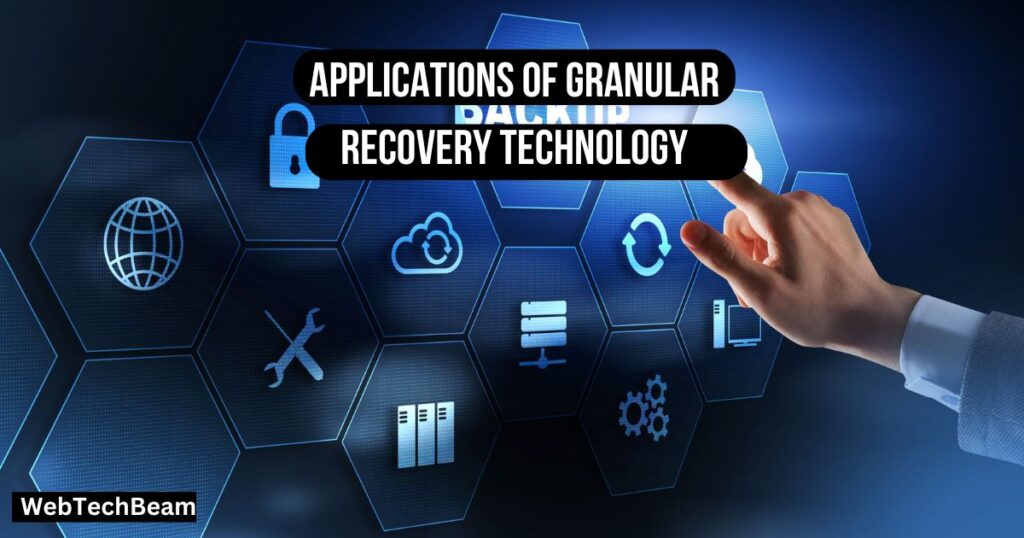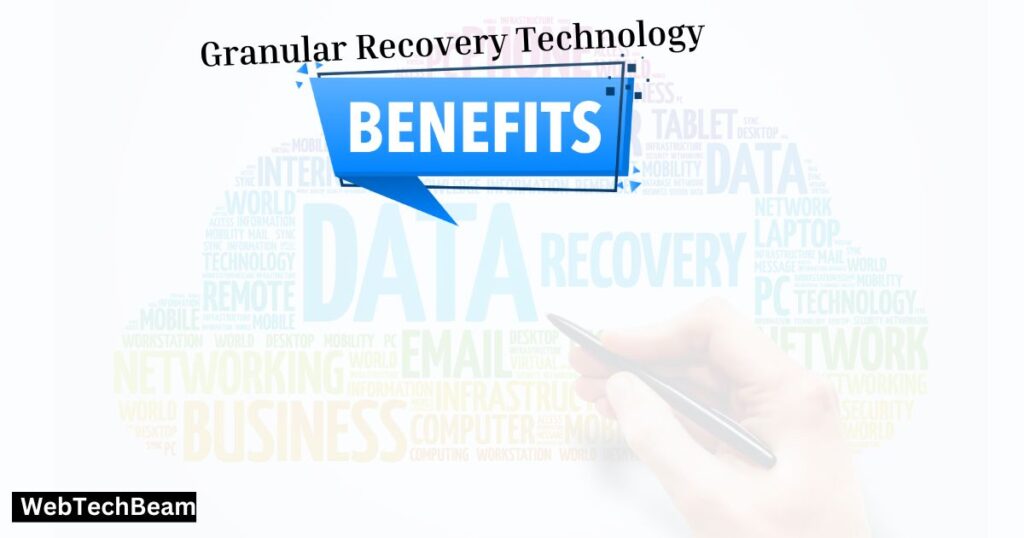Granular Recovery Technology: All Things You Should Know About

What is granular recovery technology?
Granular Recovery Technology (GRT) is a sophisticated data recovery method that allows for the restoration of specific items such as files, emails, or database entries rather than entire datasets. This precision in recovery helps save time and reduce the operational costs associated with disaster recovery.
The demand for more sophisticated data recovery methods led to granular recovery technology. In the past, data recovery required laborious system restoration procedures. The field has revolutionised with GRT, which offers a more focused and effective method.
With the development of storage technology and the increasing significance of data integrity in the digital era, Granular Recovery Technology is still evolving.
Importance of GRT in Data Management and Disaster Recovery
GRT’s importance lies in its efficiency and cost-effectiveness. In data management, GRT enables quick recovery of critical data, ensuring minimal downtime and business continuity. For disaster recovery, it provides a focused approach to restoring only the affected parts, which is both time-saving and resource-efficient.
How Does Granular Recovery Technology Work?

Technical Aspects
Core Principles
Explanation of how GRT works.
Rather than recovering entire systems or amounts of data, granular recovery technology focuses on recovering individual pieces of data. GRT makes it possible to identify the precise piece of lost or corrupted data—such as a single email, document, or database entry—that has to be recovered.
Accessing metadata and other reference points that pinpoint the precise location of the data within the storage system allows for this level of precision.
Key components involved in GRT processes.
GRT’s main elements are advanced querying methods, metadata cataloging, and data indexing. Data indexing makes it easier to map each piece of data’s location.
Metadata cataloguing provides comprehensive data on the data, such as its size, nature, and storage location. Sifting through this metadata with sophisticated querying algorithms, the particular items required for recovery are found and retrieved.
Types of data that can be recovered using GRT.
GRT is flexible and capable of restoring many different kinds of data. Examples are individual files from file systems, certain emails from mail servers, specific database records, and particular entries from various other data storage systems.
Recovery Process
Step-by-step process of granular recovery.
- Identify the Data: First, identify which specific data item needs recovery.
- Access Metadata: Use the metadata to locate the exact position of the item within the storage system.
- Query the Data: Utilize advanced querying algorithms to sift through the metadata and pinpoint the item’s location.
- Restore the Data: Extract and restore the targeted data item to its original or a new location.
Tools and software used in granular recovery.
GRT uses various specialized hardware and software to speed up the recovery process. Backup software packages with granular recovery options, such as those from Veeam, Acronis, and Symantec, are among the examples.
These programs offer intuitive user interfaces for picking individual items for recovery and browsing through metadata.
Differences between full recovery and granular recovery.
Restoring a whole system or volume is known as full recovery, and it might take a long time and a lot of resources. Granular recovery, on the other hand, is quicker and more resource-efficient since it concentrates on collecting only the impacted objects.
For total system failures, full recovery might be required. Nevertheless, GRT is the best option for recovering individual data items without incurring the costs of a complete system restore.
What is Granular Level Recovery?
Granular Level Recovery, or GRT as it is commonly known, is a technique for restoring individual, discrete data instead of a system or sizable data set.
This implies you can restore only some things if you lose a specific email, file, or database entry. Instead, you can recover just one item.
GRT is a quicker and more effective way to retrieve what you need without using up needless resources. It can save time and avoid problems associated with larger, full-system recoveries.
Applications of Granular Recovery Technology

- IT and Data Security
Role of GRT in cybersecurity.
Granular recovery technology (GRT) enables the recovery of specific targeted data following a cyberattack or breach, which is essential to cybersecurity. GRT makes it possible to restore just the impacted portions of the system, ensuring that clean data is restored without bringing back potentially dangerous components, as opposed to restoring the complete system, which may still be compromised.
Use cases in corporate data recovery plans.
Businesses frequently incorporate GRT into their data recovery procedures to promptly retrieve crucial emails or files that may have been deleted due to cyberattacks, technical malfunctions, or human error.
For example, if a crucial business contract is accidentally removed from an email archive, GRT can quickly recover the specific email without compromising other data. This reduces downtime, and the company may carry on with little interference.
- Cloud Services
Implementation of GRT in cloud data management.
Cloud service providers integrate Granular Recovery Technology (GRT) to improve data resilience and administration. GRT enables accurate recovery.
Particular elements, such as files, are among the massive volumes of data in cloud environments, where data is dispersed across various locations and systems, guaranteeing more efficiency and faster recovery times.
Benefits of using GRT in cloud environments.
Using GRT in cloud settings brings several benefits:
- Cost Savings: Only the necessary data is recovered, saving storage and computational resources.
- Speed: Faster recovery times improve overall productivity and reduce downtime.
- Flexibility: GRT allows businesses to restore critical data wherever and whenever needed, which is vital for businesses operating in different time zones and locations.
For example, a cloud-based enterprise can rely on GRT to retrieve crucial customer data swiftly in case of accidental deletion or corruption.
- Database Management
Granular recovery in relational and non-relational databases.
GRT can benefit both relational databases, such as SQL databases, and non-relational databases, such as NoSQL databases. With its assistance, large databases can recover certain entries, ensuring that certain data can be restored separately from the database as a whole.
Case studies or examples of GRT in database incidents.
Imagine a situation where a business stores client orders in a relational database. Suppose a corruption affects some records but not the rest of the database. In that case, GRT can recover only the corrupted entries.
Similar to this, GRT facilitates the effective retrieval of particular documents or data points from non-relational databases that support large-scale data operations.
For instance, an e-commerce platform experiencing issues with its customer feedback section can use GRT to restore only the feedback data without interrupting the broader database functions, ensuring customer satisfaction and continuous service availability.
Benefits of Granular Recovery Technology

Enhanced Precision in Data Recovery
One of its main benefits is the ability to use Granular Recovery Technology (GRT) with a great degree of precision. This implies that you can retrieve just what you require- a particular file, email, or even a single database entry.
It saves time and effort because only some things need to be restored. This focused strategy helps recover critical data fast and clutter-free.
Reduced Downtime and Faster Recovery Times
An additional advantage is that GRT drastically lowers downtime. The process is substantially faster because you recover individual pieces instead of entire systems or massive data sets.
With faster recovery times, your systems and services can be up and running sooner, reducing interruptions to your business’s operations. This can be especially important when time is of the essence and every second matters.
Cost-Effective Nature of Granular Recovery
Additionally, granular recovery is economical. Since you only restore the data you require, you use less storage space and processing power. This lowers expenses and improves the effectiveness of the rehabilitation procedure. Concentrating on what matters most may cut costs and preserve data integrity.
Impact on Overall Data Integrity and Reliability
Ultimately, GRT improves the general reliability and integrity of data. You may restore only accurate and necessary data by permitting focused and precise recovery. Doing this lowers the chance of data damage and keeps your systems functioning as intended.
Making educated business decisions requires having dependable and trustworthy data, which you can be sure of with GRT.
Future Trends and Innovations in GRT

Innovations and advancements in GRT.
Granular Recovery Technology (GRT) is ever-evolving, with continuous innovations aiming to improve precision, speed, and efficiency.
One promising trend is integrating blockchain technology to enhance data security and traceability. This can ensure that each piece of recovered data remains unaltered and verifiable.
The potential impact of AI and machine learning on GRT.
Another significant advancement is the application of artificial intelligence (AI) and machine learning (ML). These technologies can dramatically enhance GRT by predicting potential data losses and suggesting optimal recovery points.
AI algorithms can analyze patterns and anomalies in real time, allowing for even more accurate and quicker recovery processes. Machine learning models can also help automate the recovery process, reducing the need for manual intervention and minimizing error margins.
Predictions for the future adoption and evolution of GRT.
Looking ahead, we can expect GRT to become even more integral to data management strategies. The adoption of cloud-based solutions will likely rise, leveraging GRT for enhanced data resilience across diverse environments.
Companies will increasingly rely on GRT not just for recovery but as part of their overall data integrity and management protocols.
Enhanced AI tools will make GRT smarter, enabling more proactive and predictive recovery measures. In essence, the future of GRT is set to be more automated, intelligent, and even more indispensable.
Conclusion
We’ve explored how Granular Recovery Technology (GRT) offers flexibility by allowing precise critical data recovery whenever needed. GRT is effective for relational and non-relational databases, providing specific recovery without affecting the entire system.
It also boasts enhanced precision, reduced downtime, faster recovery, cost-effectiveness, and improved data integrity.
GRT has become vital in modern data management, ensuring fast, precise, and reliable data recovery. Its ability to restore only what is necessary saves time, reduces costs, and maintains the integrity of your data, making it indispensable for businesses facing data-related challenges.

